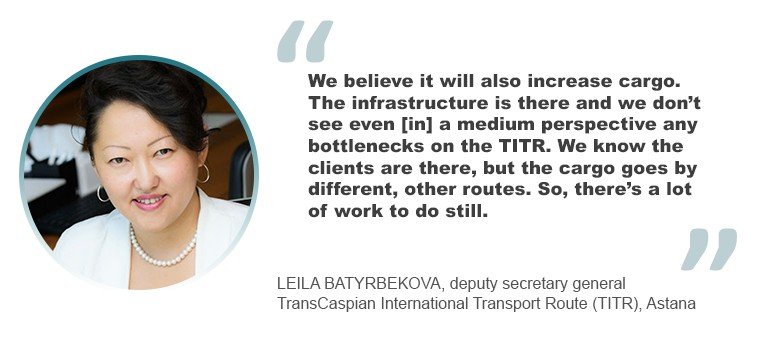Moving cargo across the Caspian Sea has become a whole lot easier, attendees at a recent webinar were told.
The webinar, Digital Integration between Ports in the Caspian Sea: A success story in Ports of Aktau and Baku webinar was held by Transport Events. Attendees heard that this one strand of the Asia-China supply chain has significantly upgraded with the digitization of links between Aktau port in eastern Kazakhstan and Baku port across the Caspian sea in western Azerbaijan.
This route is a key node in the Middle Corridor of the TransCaspian International Transport Route (TITR.) The TITR is an international organization whose members are drawn from eight countries starting in China and moving westwards towards Europe and a mix of infrastructure facilities and logistics companies.
“We can state that the ports of Aktau and Baku are integrated,” Marco Politi, vice president of sales for the DBA Group in Milan. The first sailing between the two took place in mid-June and saw all relevant data transferred via XML, he added.
Data now being shared electronically comprises data about vessels, containerized cargo, general cargo such as breakbulk, dry cargo and RoRo announcements. The last covers both vehicles and railway wagons, Eugene Seah, COO of Port of Baku, told the webinar.
The implications are more than merely connecting two ports. The technology and the procedures can be spread to include other regional and smaller ports, with Politi mentioning Turkmenbashi in Turkmenistan and unspecified ports in Iran (and later the Black Sea ports) as likely targets for expansion.
Digitization is already starting to spread along the Middle Corridor, with significant complementary initiatives both on the east and west coasts of the Caspian Sea.
On the eastern side, Kazakhstan is piloting the digitization of the TITR.
The approach has been to bring in both the public and private sectors by blending infrastructure facilities such as ports and railways and private sector companies, most noticeably freight forwarders to create a single information space.
Currently, it is integrating the participants of the pilot with testing proper, which started on July 1, 2021, and will run through till the end of October. This will be followed by the creation of a unified digital TITR corridor for all participants which will last through October 30 ,2022, said Andrey Klochkov, head of marketing and strategy development at Kazakhstan’s KTZ railway.
On the western side, in Azerbaijan, a key driver is the national railway company’s aim to make the movement of cargo easier. Data entry is done only once and done by the operators.
A goal has been to reduce time spent on document processing at control points, Ilgar Mustafayev, chief engineer in the freight department of Azerbaijan Railways (ADY), told the webinar. The key to this has been getting all participants aligned, particularly at hub points and borders.
“I think it’s important to integrate railway systems, the port systems with local customs agencies to reduce this customs clearance of the cargo,” Mustafayev said, adding “full transition” from paper to electronic information exchange was important, but hampered by national laws and regulations.
On top of that depth, what ADY is pioneering also has some geographical reach, both within its home base and overseas. “Right now, the system is currently used in almost 100 ADY stations,” Mustafayev said, adding that the system was already integrated with Russian and Kazakhstan railway systems. On top of that, ADY is piloting data exchange with the port of Baku and was doing test runs on Georgian railways as well as being in negotiations with Turkmenistan Railways across the Caspian Sea.
Mustafayev has some useful advice in dealing with the obstacles to full integration: integrate within one country first before trying to integrate transnationally.
“One of the bigger problems – the non-digitization – is starting to [no longer be] a problem,” Politi said of the Baku-Aktau link, but this is also is beginning to apply along the Middle Corridor and might be able to expand elsewhere in future.
Hopefully this will allow the TITR to deal with the other problem it has: lack of use, as Kazakhstan’s exports sink, owing to the pandemic.
“We believe it will also increase cargo,” said Leila Batyrbekova, deputy secretary general of the TITR in Astana. “The infrastructure is there and we don’t see even [in] a medium perspective any bottlenecks on the TITR.”
In the first four months of this year, 154,000 tons was transported – “a lot less” than the same period last year, according to Batyrbekova, who estimated the slump at 40%. Adding to the routes complications is its disequilibria. “It’s not super-balanced I would say,” she added.
The real issue though is improving the flow of goods down Middle Corridor and using that to open up new markets and new routes such as Central Asia-Africa. “We know the clients are there,” she said, “but the cargo goes by different, other routes. So, there’s a lot of work to do still.”



